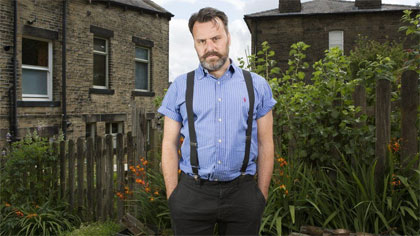
Author Benjamin Myers on the crop circle makers who ‘blew people’s minds’
By Ian Youngs
Entertainment and arts reporter
The sun sets on a crop circle in Dorset in 2019. The formation depicts the Tree of Life, a mystical symbol used in the ancient Jewish tradition of Kabbalah.
Crop circles continue to appear in English fields during the summer
Mysterious patterns in crop fields caused a sensation in the late 1980s, blamed on aliens or paranormal activity. Now, a new novel has been inspired by some of the men who provided a more mundane explanation – without completely putting the theories to rest.
When Benjamin Myers went back home to Durham for a holiday in 2019, burned out after publishing nine books in 10 years, he did not want to think about writing another.
“I went there for a rest because I was completely fried,” the West Yorkshire-based author says.
To get away from it all, he took a country walk, ending up in the middle of a crop field, in the middle of nowhere – the perfect escape.
But as he stood waist deep in barley, Myers says the outline for his next book arrived in his head virtually fully formed – in the space of 10 seconds.
“I just thought, ‘You should write a book about two men who make crop circles over the course of the summer of ’89 and they’ll be called this and there’ll be 10 chapters and they’ll take place at night,'” he says.
“Then I thought, ‘No, I don’t want to do that.’
“I was sort of arguing with myself.
“I thought, ‘I don’t want to write a book – shut up, you’ve come for a rest.'”
 Benjamin Myers
Benjamin Myers
One of Benjamin Myers’ previous books is being turned into a BBC drama by Shane Meadows
His imagination – or perhaps some other higher force – got the better of him.
“Without being too cosmic about it, it sort of felt like I just downloaded the whole thing from the ether,” he says.
‘Total sceptic’
The power of crop circles to intrigue and inspire appears to have dimmed little since they entered the public consciousness in the late ’80s.
Then, the press and self-proclaimed experts delighted in speculating on what strange and other-worldly forces may have created the intricate geometric designs that appeared overnight in fields, mostly in the south-west of England.
But despite his bolt of inspiration in the barley field, Myers, 46, has always been “a total sceptic” about their origins.
He says: “The thing I remember in the press at the time was the alien visitation – ‘Is it UFOs?’ – and a lot of talk from experts and academics from made-up universities in Wyoming or whatever, saying, ‘Humans can’t possibly have made this.’
“Even at 13 I thought, ‘Of course they can.'”
Dave Chorley making a crop circle with a plank of wood in 1991
Dave Chorley, one of the godfathers of crop circles, demonstrating with a plank of wood in 1991
In 1991, two middle-aged men provided an answer – Doug Bower and Dave Chorley demonstrated how they had made crop circles, armed only with planks of wood and lengths of rope.
But Myers was more interested in why such breathtaking designs would be made – especially by people who initially had had little interest in claiming credit.
“To me, the fact that anonymous unknown humans made these crop circles is more interesting to me than any conspiracy theory or UFO stuff,” he says.
“So the jumping-off point for the book was really, ‘Why would people do this?'”
The Perfect Golden Circle is the story of a tender friendship between two men, Redbone and Calvert – not directly based on Bower and Chorley, the author says – who sneak into fields to flatten crops into elaborate formations simply “to inspire awe and bafflement and just to blow people’s minds”.
“I didn’t remember any articles about the artistry or the spectacle of this landscape art,” Myers says. “So that’s what I wanted to celebrate, really.”
Crop circles in a field near Salisbury, UK, 23rd July 1990
This formation, from Wiltshire, in 1990, was used on a Led Zeppelin album cover
Others, though, have been less willing to believe the phenomenon is simply down to people with planks.
In 2000, a study funded by Laurance Rockefeller, one of America’s richest men, claimed 20% of crop circles were due to the Earth’s magnetic fields.
Monique Klinkenbergh, who set up Wiltshire’s Crop Circle Exhibition and Information Centre, says on the venue’s website the “crop-circle phenomenon is about a form of ‘contact’ or nature we don’t yet understand”.
And even mortal circle-makers have reported unexplained events such as hovering lights, in the days before drones, while they were flattening fields.
Temporary temples
John Lundberg started making crop circles while at art school in the early 1990s, simply “to see what was humanly possible – and if you did make a crop circle, what would happen”.
His very first creation, with fellow artist Rod Dickinson, immediately became accepted “as part of the genuine phenomenon, meaning non-human origin”.
“People were having funny feelings in it and their crystals were vibrating and their dowsing rods were going crazy,” Mr Lundberg says.
The pair had intended to make a one-off – but the reaction “sucked me back into the fields”.
“We basically leave these gifts for people and they’re like temporary temples,” Mr Lundberg says, “and people go into them and interact with them however they see fit.”
Aerial view of people in a crop circle in Wiltshire in 2010
Many farmers dislike the influx of visitors that follows the appearance of a crop circle
Circle-makers themselves also often feel a deep connection with the landscape and its ancient mystique while stamping their designs at night.
“You do feel maybe part wizard, part shaman,” Mr Lundberg says.
“So there is, on one level, that kind of spiritual experience.
“But on the other level, you’ve got diagrams and you’ve got a job to do and you’ve got to get on with it.”
Despite having made crop formations as land art for 30 years, even he says: “I would like to believe that there are some crop circles that are of non-human origin.”
And perhaps maintaining some mystery is crucial to the art.
“Without an audience, the crop circles don’t function,” Mr Lundberg says.
“They need an audience – they need participation.”
Social outsiders
Redbone, despite his creator’s scepticism, also likes to believe something mysterious and magical is going on. He thinks his most elaborate patterns may be channelled through him “from somewhere far more deeply rooted, from 10,000 lifetimes ago, from all lives lived, in all places”.
He is “a sort of anarcho-punk, crusty, new-age traveller crossover”, Myers says. With troubled Falklands War veteran Calvert, the pair represent a pocket of subversion and individuality at a time when politicians, police and the press – as well as creeping surveillance – seemed to be funnelling counterculture into conformity and control.
The author is fond of folk heroes rooted in English landscape and history.
His award-winning 2017 book The Gallows Pole, about an 18th Century coin-clipping gang, is currently being turned into a BBC drama by director Shane Meadows.
In The Offing, from 2019, a reclusive woman on the Yorkshire coast forms an unlikely friendship with a restless young man from mining stock in the wake of World War Two. It became a surprise lockdown bestseller in Germany.
Most of Myers’ characters are social outsiders in one way or another. “Because I feel like that myself a lot of the time”, he says.
“The two characters in the [new] novel are happiest at night, by themselves or with each other, in a field under the cover of darkness.
“I can relate to that.”
The Perfect Golden Circle by Benjamin Myers is out now.




















